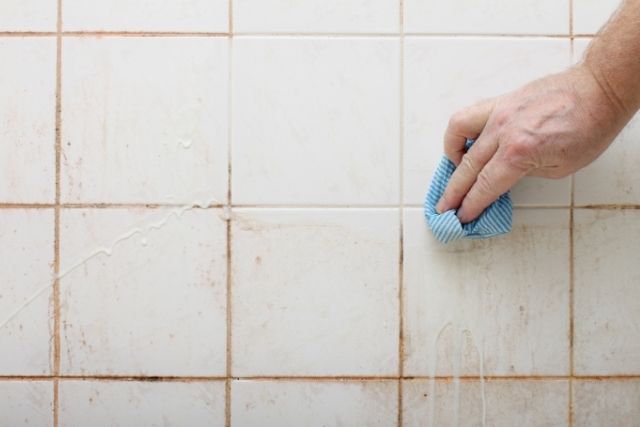How to Clean Bathroom Tiles
It’s truly astonishing—and somewhat unsettling—to see the amount of mold and mildew that can accumulate in the crevices of bathroom tiles. This issue arises because bathrooms tend to remain wet and humid, creating the perfect environment for mold growth. Regular cleaning of your bathroom tiles is crucial to prevent excessive mold buildup. In this guide, we’ll share expert advice on the best methods for cleaning bathroom tiles, ensuring they stay shiny and free from soap scum.

Before Cleaning: Know Your Tiles
Before you start, it’s very important to know the kind of tiles in your bathroom. Alex Rivers, a cleaning expert, says you can clean ceramic and porcelain tiles with a mix of half lemon juice or white vinegar and half water. But, marble or stone tiles can get ruined by acid, so it’s better to use special cleaners for marble or stone, or a mild soap (like Liquid Ivory or Palmolive) mixed with water. Always stay away from harsh cleaners because they can scratch any tile. If your bathroom has different kinds of surfaces and you’re worried about acid harming stone or marble, Rivers recommends just using soap and water.
How Often You Should Clean Bathroom Tiles
This really depends on your available time. Jamie Taylor, a professional home cleaner, suggests cleaning your bathroom tile once a week if you can.
For many busy people, cleaning the tile once a month is more doable. “For the guest bathroom that isn’t used often, cleaning it once every three months or before a guest comes—whichever happens more—should be enough,” says Taylor. “It’s also good to clean the tile after your guests leave, so you’re ready for any surprise visitors.”
In every situation, it’s helpful if everyone uses a squeegee on the tiles after using the bathroom. “This reduces soap scum buildup and decreases moisture that can lead to mold growth,” Taylor mentions.
Tools and Ingredients for Sparkling Tiles
What You Need to Clean Bathroom Wall Tiles:
- Gloves
- Sponge
- Cleaning cloths
- A toothbrush or a small brush with soft bristles
- Lemon juice, white vinegar, or mild soap
- Baking soda
- Water
- Squeegee
- Spray bottle
What You Need to Clean Bathroom Floor Tiles:
- Mop
- Mild dish soap
- Broom
- Swiffer and dry pads
- Bucket of water
How to Clean Bathroom Tiles Properly
Step-by-Step Guide: Wall Tiles:
- First, clean the spaces between tiles. Put on a paste made from baking soda, or for really tough or dark stains, use a mix of baking soda and white vinegar.
- Wait for a few minutes and then scrub with a toothbrush.
Note: Be gentle with very old or not well-kept grout because it can fall apart. - Wash it off thoroughly.
- For cleaning the tiles, begin at the top, where the tiles touch the ceiling, and put on your cleaning solution. You can make your own cleaner by mixing half dish soap and half water, or a quarter white vinegar, a quarter lemon juice, and half water. Put this mixture in a spray bottle to use on the tiles. Let it sit for a few minutes to help loosen any dirt and buildup.
- Use a soft brush or sponge to gently scrub the dirt away in circular motions. Start from one side of the wall and move across, then go down a row of tiles and repeat. This method helps you cover every spot without missing any. But, if you come across heavy buildup, limescale, or hard water stains, you’ll need to scrub harder.
- Wash it off with warm water using a cloth or sponge.
- Use a squeegee to remove the water and then dry it off with a clean cloth.
- Make sure not to leave any wetness behind because it can cause streaks or spots and add dampness to the area, which can lead to mold growing.
Floor Tile Cleaning:
- First, use a broom or a Swiffer to sweep the floor.
- Put 1 to 2 tablespoons of dish soap into a bucket of water and mix it.
- Clean the floor tiles with a mop.
- After mopping, use a dry pad on the Swiffer to dry the floor tiles and prevent mold growth.
Advice on How to Clean Bathroom Tiles
When cleaning your bathroom tiles, remember a few tips. “For harder stains, you can make a paste with hydrogen peroxide, baking soda, and a bit of dish soap,” advises Taylor. “Put it on the stain, wait five minutes, then scrub gently with a soft brush.” Don’t use this on stone, and test it on a small area first to make sure it doesn’t change the color.
Taylor also recommends staying away from bleach. If you need it for very tough stains, choose Oxy Bleach powder because it’s gentler and less harmful. Also, remember to improve airflow in the bathroom while cleaning.
“Preventing problems is easier than fixing them,” Taylor says. “We tell our clients to re-seal the spaces between tiles every six months. The sealant fades away, making these areas more likely to get wet and grow mold.” It’s also important to regularly use the right sealer for stone tiles to protect them.